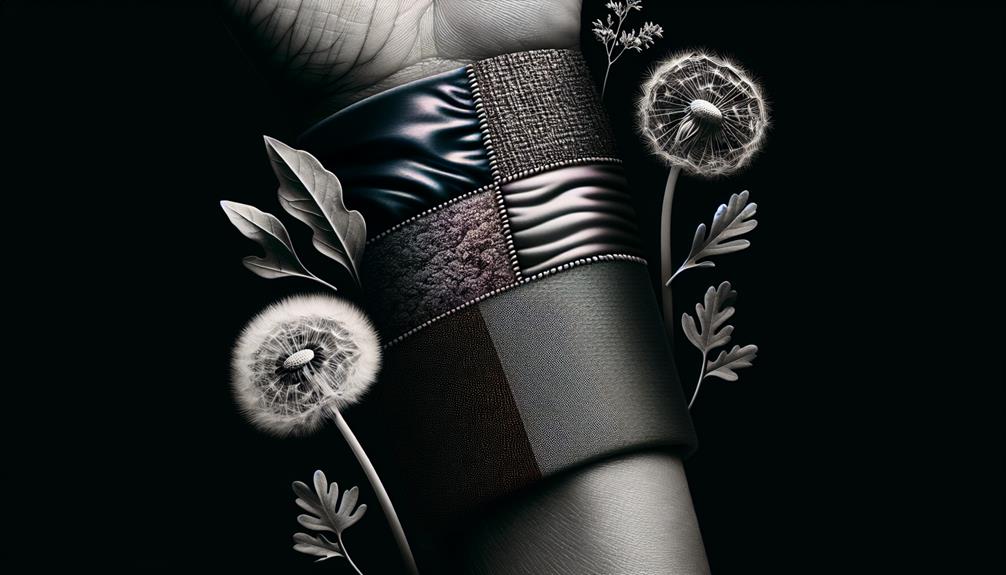I've noticed that whether chiffon is itchy or not really depends on what it's made of and how it's been treated. Chiffon can be woven from silk, polyester, or a mix of both. Generally, silk chiffon feels smoother and less itchy against the skin, while polyester chiffon can be a bit rougher. The tightness of the weave and any chemical treatments can also make a big difference. If you pick high-quality chiffon and wash it before wearing, you're less likely to find it itchy. There's a bit more to know about keeping comfy with chiffon, too.
Table of Contents
Key Takeaways
- Chiffon can be itchy depending on material composition; silk is smoother, polyester may feel rougher.
- Quality of the fabric blend and weave tightness significantly affect skin comfort.
- Chemical treatments and dyes used in chiffon fabrication can contribute to itchiness.
- Proper pre-wearing washing can help reduce potential irritation from chemicals.
- Layering garments underneath chiffon can alleviate skin irritation by reducing direct contact.
Understanding Chiffon Fabric
Chiffon is a lightweight, sheer fabric often made from silk, polyester, or nylon. I've always been intrigued by how it manages to be both delicate and durable at the same time. Typically, chiffon is used in evening wear, especially as an overlay, to give an elegant and floating appearance to gowns and dresses. It's also popular in blouses, scarves, and lingerie.
When you're looking into chiffon, you'll find it's woven in a way that allows a slight stretch; its mesh-like weave gives it a bit of give. That's why it drapes so beautifully. The weaving process involves twisting yarns, which results in the slight puckering you see on a finished garment. This unique characteristic of chiffon helps it to catch the light, creating a soft shimmering effect.
If you're considering buying chiffon, it's good to know that it comes in various finishes. You can find chiffon that's lightweight or heavyweight depending on the type of garment you want to create. Each type holds dye well, which means you're likely to find chiffon in a wide range of colors and patterns. Whether you're crafting a dramatic evening gown or a simple summer dress, chiffon offers versatility and enduring appeal.
Chiffon Texture Analysis
Let's start by looking at what chiffon is made of and how this affects its feel against the skin.
We need to consider how sensitive skin reacts to this fabric, as it can really make a difference in comfort.
Chiffon Fabric Composition
Examining the composition of chiffon reveals that it's typically made from silk, polyester, or a blend of both. These materials contribute to the distinctive texture and feel of chiffon. Silk chiffon is prized for its softness and natural sheen, while polyester chiffon is durable and more resistant to creasing. Blends of silk and polyester aim to offer the best of both worlds, balancing beauty and practicality. Here's a simple breakdown:
| Material Type | Properties | Common Uses |
|---|---|---|
| Silk | Soft, luxurious | Evening wear |
| Polyester | Durable, less wrinkle-prone | Everyday outfits |
| Silk-Poly Blend | Balanced features | Versatile clothing |
Understanding these details can help in choosing the right chiffon for your needs, ensuring comfort and style.
Skin Sensitivity Considerations
When considering a fabric like chiffon, it's important to think about how it might affect sensitive skin. Chiffon's texture varies depending on its composition—silk, polyester, or a blend. Silk chiffon is generally smoother and feels softer against the skin, reducing the risk of irritation. On the other hand, polyester chiffon can be slightly rougher, and if you've got skin that reacts easily, this can be a bit of an issue.
I've found that the tightness of the weave also plays a role. A looser weave in silk chiffon allows it to breathe more, which is better for sensitive skin. Always check the fabric's texture by rubbing it against your skin—if it feels scratchy at all, it's best to steer clear.
Comfort and Wearability Factors
Chiffon's unique texture plays a big role in how comfortable it feels to wear. As I've explored various fabrics, I've noticed that chiffon has a light and airy feel, which significantly impacts its wearability. Here's what stands out about chiffon:
- Sheer Elegance: The almost transparent nature makes it perfect for overlaying without feeling bulky.
- Soft to the Touch: Despite its delicate appearance, it's surprisingly soft against the skin.
- Flexible Drape: Chiffon flows beautifully and conforms to body movements.
- Breathable Fabric: It doesn't trap heat, making it ideal for warmer climates.
- Slight Stretch: Offers a hint of give, which enhances comfort.
These qualities make chiffon a popular choice for those wanting both style and comfort in their wardrobe.
Common Uses of Chiffon
Over the years, chiffon has become a popular choice for elegant evening wear, airy blouses, and flowing scarves. This fabric's versatility extends beyond just these items, though. I've found it's also fantastic for layered dresses and delicate lingerie. Its lightweight nature makes it a dream for soft, romantic looks that float beautifully and catch the slightest breeze.
Check out this table that paints a pretty clear picture of where you might spot chiffon:
| Use Case | Description |
|---|---|
| Evening Gowns | Adds elegance with its sheer texture |
| Blouses | Perfect for breathable, chic outfits |
| Scarves | Lightweight, adds a pop of style |
| Wedding Dresses | Creates a fairy-tale, ethereal effect |
| Lingerie | Gentle against the skin, alluring |
Each use capitalizes on chiffon's unique properties: its sheerness and lightness. This makes it a staple in any designer's fabric arsenal, especially when aiming for garments that need a bit of flow or a delicate touch. Its ability to layer without adding bulk keeps outfits looking sleek and sophisticated. If you're crafting or choosing a piece that needs to embody grace and airiness, chiffon's your go-to fabric.
Chiffon Fabric Composition
Understanding chiffon fabric composition starts with recognizing that it's primarily made from silk, polyester, or a blend of both. Each material brings its own unique qualities to the chiffon, influencing not just the texture and feel but also the fabric's behavior and suitability for different uses.
Silk chiffon is the original and is celebrated for its luxurious feel and natural sheen. It's incredibly soft and has a slight weight that makes it drape beautifully. Polyester chiffon, on the other hand, is more durable and resistant to wrinkles, which makes it a popular choice for everyday wear and easier maintenance.
When you mix silk and polyester, you get a fabric that combines the best of both worlds. It maintains some of the elegance of silk while incorporating the resilience and practicality of polyester. This blend is particularly popular in fashion because it offers a good balance between cost, appearance, and ease of care.
Here's what to picture when you think about chiffon:
- *A flowing evening gown shimmering under soft lighting*
- *A lightweight scarf fluttering in the breeze*
- *A delicate blouse that feels almost weightless*
- *Curtains that dance lightly with the wind*
- *A layered skirt that twirls gracefully with every step*
Each type of chiffon brings these images to life in its own way, depending on its composition.
Factors Influencing Itchiness
Several factors determine whether chiffon fabric feels itchy, including its material composition and the finishing processes used. Let's dive into these aspects to see why they matter.
First off, the base material of chiffon can be silk, polyester, or a blend. Silk chiffon is generally smoother and less likely to itch, while polyester chiffon mightn't feel as soft, leading to potential discomfort. The blend's quality also plays a crucial role; cheaper materials are often rougher, which can trigger itchiness.
Then there's the finishing process. Chiffon fabrics undergo various chemical treatments and mechanical processes to achieve that desirable sheerness and drape. These chemicals, if not thoroughly washed out, can leave residues that irritate the skin. Moreover, the dyes used for coloring chiffon can also be a factor. Some dyes contain allergens that make the fabric itchy for sensitive individuals.
Considering these elements, it's clear that both the type of fibers used and how the fabric is processed influence the itchiness of chiffon. Understanding these factors helps in choosing the right chiffon fabric that won't cause discomfort, especially if you're planning to wear it for extended periods.
Skin Sensitivity and Chiffon
When it comes to chiffon, not everyone reacts the same way; it really depends on your skin's sensitivity.
We'll look at what it's about chiffon's properties that might irritate sensitive skin.
Then, I'll show you some tips on how to handle chiffon if it tends to make you itchy.
Chiffon Fabric Properties
Chiffon fabric is generally gentle on the skin, but its compatibility can vary depending on individual sensitivities. Here's a quick rundown of its properties:
- Lightweight and Airy: Imagine the fabric floating elegantly as a light breeze passes through.
- Slightly Rough Texture: While it has a graceful drape, its surface isn't as smooth as silk.
- Translucent Appearance: Holds a hint of mystery with its semi-transparent look.
- Durable yet Delicate: It's strong enough for regular wear but requires careful handling.
- Absorbs Moisture: Good for staying cool, but can be an issue if you're sensitive to dampness.
I've found that understanding these characteristics helps in choosing the right fabric for your skin type.
Managing Chiffon Irritation
If you find chiffon irritating your skin, there are several steps you can take to manage this sensitivity. First, always opt for high-quality chiffon, as cheaper versions may contain harsh chemicals or rough fibers. It's also a good idea to wear a light cotton undershirt beneath chiffon tops or dresses. This creates a barrier between your skin and the fabric.
Here's a quick guide to help you deal with chiffon irritation:
| Strategy | Description | Benefit |
|---|---|---|
| Choose Quality | Select high-grade chiffon to avoid additives | Reduces irritation |
| Layer Clothing | Wear an undershirt to protect your skin | Prevents direct contact |
| Wash Before Use | Clean new chiffon items to remove residues | Eliminates potential irritants |
Chiffon Care Practices
To keep your chiffon looking its best, proper care is essential. I've learned through trial and error that this delicate fabric demands a gentle touch. Here's a straightforward guide to help you master the art of caring for chiffon, ensuring that your garments remain pristine and comfortable for years to come.
Here are my top five tips:
- Hand Wash Gently: Avoid the rough-and-tumble of a washing machine. I use cool water and a mild detergent to softly wash my chiffon items.
- Avoid Wringing: To prevent damage, I never wring out chiffon. Instead, I carefully press the water out between two towels.
- Air Dry: I always hang chiffon garments on a padded hanger to air dry. Direct heat from a dryer can be disastrous.
- Cool Iron: If there are wrinkles, I use an iron on the lowest setting with a pressing cloth between the iron and the fabric to avoid scorch marks.
- Proper Storage: I store chiffon away from rough materials and ensure it's loosely folded or hung without overcrowding to avoid creases.
Choosing Quality Chiffon
After mastering the care of chiffon, I've found that selecting high-quality material is just as important for ensuring longevity and comfort. When you're in the market for good chiffon, you need to kick the tires a bit, so to speak.
First and foremost, pay attention to the feel of the fabric. Quality chiffon should feel smooth and not scratchy against your skin. If it feels rough or brittle, chances are it's not going to wear well.
Look closely at the weave. High-quality chiffon will have a tight, even weave that's free from obvious flaws like snags or pulls. This detail often separates the superior from the mediocre. Additionally, the fabric should have a slight sheen, but not be overly shiny. Overly shiny chiffon can indicate a high synthetic content, which mightn't breathe as well as you'd like.
Check the edges of the fabric, too. They should be neat and well-finished. Frayed or uneven edges are a dead giveaway of poor manufacturing. Finally, consider the weight. Quality chiffon is light but not too flimsy. It should have enough body to drape beautifully without being too bulky. Choosing the right chiffon means balancing these factors, but it's worth the effort for the comfort and elegance it brings to your wardrobe.
Alternatives to Chiffon
While chiffon offers elegance, exploring other fabrics can provide new textures and benefits for your wardrobe. If you're like me, always on the lookout for comfort and style, knowing your options can make a big difference.
Here are some great alternatives to chiffon that you might consider incorporating into your outfits:
- Cotton Voile: Lightweight and breathable, it's perfect for those hot summer days when you want something light but not clingy.
- Silk Crepe: Known for its slightly crinkled texture, silk crepe is luxurious and drapes beautifully, making it a fantastic option for formal wear.
- Rayon: With a silky texture, rayon hangs well and feels soft against the skin, serving as a wonderful all-purpose fabric.
- Modal: Derived from beech trees, modal is eco-friendly and incredibly soft, often used in casual wear because of its comfort.
- Georgette: Similar to chiffon but slightly heavier, georgette offers a bit more structure while still maintaining that floaty feel.
These fabrics not only diversify your style options but also cater to different comfort needs, ensuring you're not only stylish but also at ease, no matter the occasion.
Wearing Chiffon Comfortably
Despite its elegance, wearing chiffon comfortably often requires a bit of extra effort and the right accessories. I've found that choosing the right undergarments is crucial. A smooth, seamless bra and slip can prevent the chiffon from clinging to your body or causing irritation. It's also a good idea to opt for undergarments that match your skin tone or the color of the chiffon to avoid any visible lines or contrast.
Layering is another technique I use to enhance comfort. A light cotton or silk camisole can provide a barrier between my skin and the chiffon, especially if I'm wearing a chiffon blouse. This not only helps with comfort but also maintains the flowy, elegant look of the fabric.
I also pay close attention to the fit of chiffon clothing. Pieces that are too tight can restrict movement and make the material feel scratchy. I always make sure there's a bit of looseness, which allows the fabric to drape beautifully without causing any discomfort.
Lastly, when I choose chiffon, I look for higher quality fabric. Higher quality chiffon tends to be softer and less likely to irritate the skin, making it a worthwhile investment for both comfort and durability.
Tips for Sensitive Skin
If you have sensitive skin, choosing the right chiffon can make a big difference in comfort. I've found a few tricks that really help me avoid discomfort and irritation when I wear chiffon, which is known for its light and airy feel but can sometimes cause issues for those of us with more delicate skin.
Here are my top tips:
- Choose silk chiffon over synthetic: Silk is naturally hypoallergenic, making it less likely to irritate.
- Pre-wash with a mild detergent: Washing new fabrics can remove irritants that might cause a reaction.
- Test wear: Before going out, wear your chiffon outfit at home to see if it causes any discomfort.
- Layer wisely: Wear a soft cotton underlayer to protect your skin from direct contact with chiffon.
- Stay moisturized: Apply a gentle, unscented lotion before dressing to create a barrier between your skin and the fabric.
Frequently Asked Questions
Can Chiffon Fabric Shrink or Stretch Over Time?
Yes, chiffon fabric can shrink or stretch over time, especially if it's not handled correctly. I've noticed it's best to follow care labels closely to maintain its shape and size.
Does Chiffon Fabric Offer UV Protection?
Chiffon's like a thin curtain; it doesn't block all UV rays. I've found it offers minimal protection compared to thicker fabrics. It's better to use sunscreen or wear a denser material for safety.
Is Chiffon Suitable for Winter Wear?
Chiffon isn't ideal for winter wear as it's lightweight and doesn't offer much insulation. I'd recommend layering it or opting for warmer fabrics to stay cozy in colder months.
How Does Chiffon Impact the Environment?
Chiffon's production isn't very eco-friendly. It's usually made from synthetic materials like polyester, which involve harmful chemicals and emissions. I'm looking into more sustainable alternatives to reduce my environmental impact.
Are There Hypoallergenic Treatments Available for Chiffon?
Yes, there are hypoallergenic treatments available for chiffon that can reduce skin irritation. I've found that these treatments make chiffon much more comfortable to wear, especially for those with sensitive skin.





